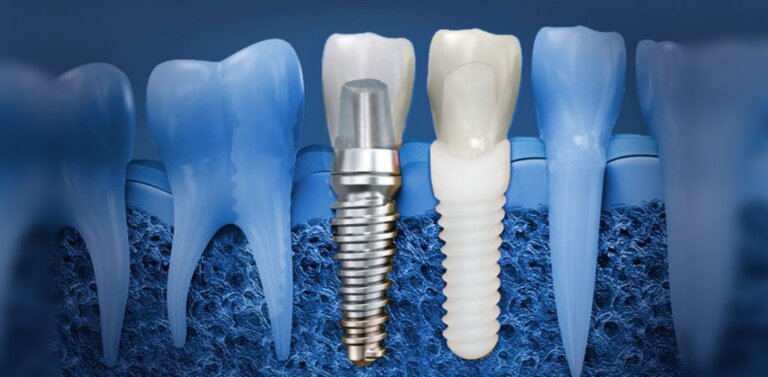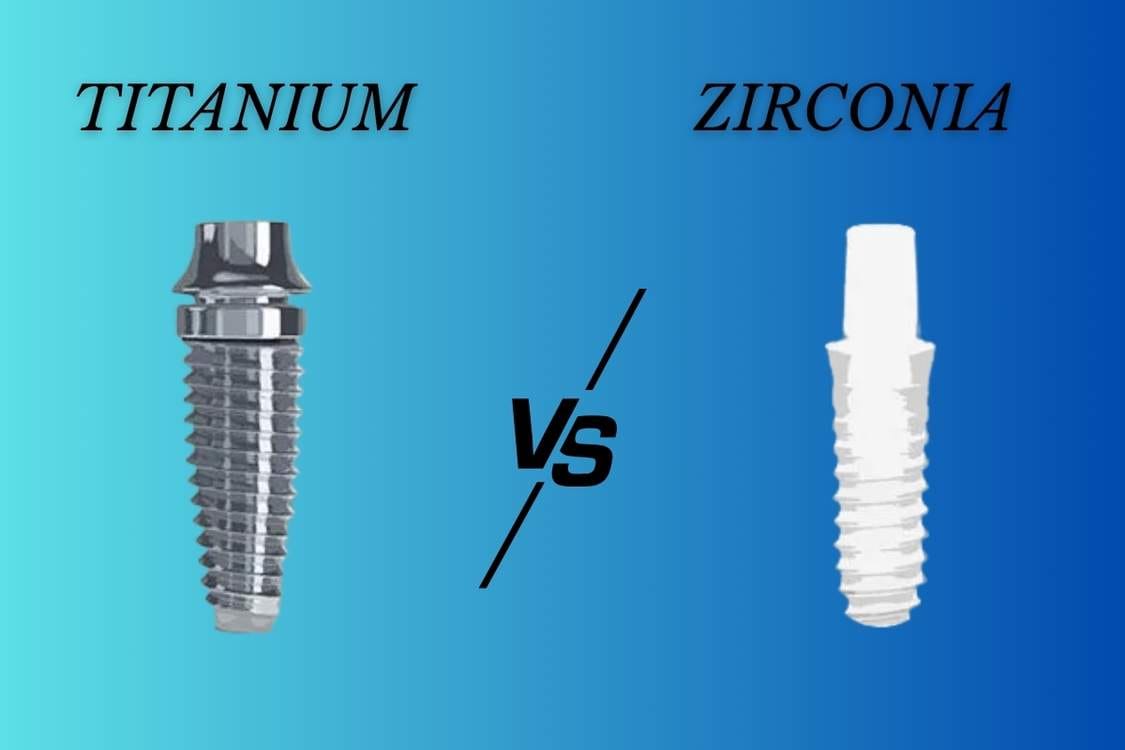When planning a smile restoration, the material used for the implant post itself is as critical as the surgeon’s skill. For decades, titanium has been the unchallenged champion of dental implants. However, the rise of Zirconia (a ceramic material) presents patients with a choice that demands careful consideration. Choosing the right material—dental implants zirconia vs titanium—affects everything from the final cost and surgical process to aesthetics and long-term health.
If you are one of the thousands traveling to Turkey for high-quality, cost-effective dental treatment, understanding these differences is essential. This guide breaks down the science, the pros, the cons, and the clinical outcomes to help you select the optimal foundation for your new, permanent smile.
Titanium Implants: The Established Industry Standard
Titanium has dominated the implant market for over 50 years, and for good reason. It remains the most widely studied and clinically proven material in modern implant dentistry.
Strength, Success, and Longevity
Titanium is a highly biocompatible metal, meaning the body accepts it readily. Its key advantage is a phenomenon called osseointegration, where the jawbone fuses directly with the implant surface. Clinical studies confirm that titanium implants maintain an exceptionally high long-term success rate, generally cited between 95% and 98% over ten years (Source: NCBI/NCBI).
Titanium’s high tensile strength also makes it ideal for supporting substantial biting forces, especially when replacing molars or supporting full-arch restorations like All-on-4. The material is typically alloyed with small amounts of metals like zirconium or vanadium to maximize strength.
What are the disadvantages of titanium implants?

While titanium is the standard, it is not without drawbacks. The main issue is aesthetics: the gray color of the metal post can sometimes show through thin gum tissue, creating a visible shadow known as “graying” (especially in the anterior, or front, teeth). For patients with metal allergies or sensitivities, titanium can occasionally be problematic, although pure titanium is generally hypoallergenic.
Zirconia Implants: The Aesthetic and Ceramic Alternative
Zirconia (specifically Zirconium Dioxide, a ceramic compound) represents the next generation of implantology. These metal-free implants offer specific advantages, particularly in aesthetics and biocompatibility.
The Aesthetics of Zirconia
The primary benefit of choosing zirconia vs titanium dental implants is aesthetics. Zirconia is white, meaning it perfectly mimics the color of a natural tooth root. This eliminates the risk of a visible gray ring or shadow at the gum line, making it the preferred choice for patients receiving implants in the highly visible front aesthetic zone. Furthermore, plaque adheres less readily to zirconia surfaces, which can promote healthier gum tissue around the implant (Source: Dental Master Med).
Design and Biomechanics
Early zirconia implants were one-piece designs, limiting flexibility. However, modern systems now offer two-piece designs, similar to titanium, allowing for better alignment flexibility and easier restoration. Zirconia is incredibly hard (ceramic), though its brittleness compared to titanium’s flexibility means it must be handled precisely during surgery.
What are the disadvantages of zirconia implants?
While highly aesthetic, zirconia implants present two main challenges:
- Cost: They are generally more expensive than their titanium counterparts due to higher manufacturing costs and specialized fitting techniques.
- Experience: Fewer clinicians worldwide have extensive, long-term experience with zirconia compared to titanium, although this is rapidly changing in advanced dental centers in places like Turkey.
Navigating Costs: Why Zirconia Implants Cost More
Understanding the final price of an implant requires looking beyond the raw material and recognizing the distinct cost drivers for each system. While both titanium and zirconia implants require the same preparatory procedures (like bone grafts or extractions), their specialized manufacturing and installation requirements dictate the final price tag.
Titanium Dental Implants: The Cost-Effectiveness of Scale
Titanium remains the more affordable choice primarily due to its maturity in the market. Its cost factors reflect a highly efficient, decades-old production process:
- Raw Material & Production: Titanium is a mass-produced, industrial material. Its efficient, large-scale milling and production processes make the implant post significantly cheaper than ceramic alternatives.
- Established Technology: The long history of titanium means the specialized surgical tools and equipment are common and widely available, minimizing high-tech overhead costs for the clinic.
- Dentist Experience: Most oral surgeons have extensive experience with titanium systems, making it the standard procedure and keeping the general fee structure consistent.
Zirconia Dental Implants: The Price of Premium Aesthetics

Zirconia implants always command a higher price—often 20% to 50% more than titanium—due to the complexities of ceramic science and aesthetics. This price difference is unavoidable globally, including in Turkey.
- Ceramic Manufacturing Complexity: Zirconia requires a more intricate and precise manufacturing process (sintering) than metallic titanium. This results in a higher raw material and production cost for the manufacturer.
- Laboratory Customization: Zirconia posts are white and must perfectly match the patient’s gum tissue for superior aesthetics. Intricate color, shading, and shape customization of the ceramic abutment and crown require specialized lab work, increasing laboratory expenses.
- Specialized Expertise: Placing zirconia requires specific surgical precision, as the ceramic material is harder and less flexible than titanium. Dentists with extensive experience in zirconia often charge higher fees due to their specialized skills and investment in advanced ceramic dental technology.
Turkey’s Cost Advantage
While zirconia remains pricier than titanium within any single clinic, Turkey’s structural economic benefits minimize the financial impact of both materials. Due to the favorable exchange rate and lower labor costs, even a premium Zirconia implant in Turkey averages $800 – $1,200, a price significantly lower than a basic titanium implant in the US.
Choosing Your Material: Strength, Sensitivity, and Cost
When deciding between titanium vs zirconia dental implants, patients traveling to Turkey should consider these three factors:
Is Zirconia More Expensive Than Titanium?
Yes, zirconia is more expensive than titanium. The initial cost difference can be between 20% and 50% higher for a zirconia implant due to the specialized manufacturing process and equipment required for ceramic materials. However, in countries with lower labor costs like Turkey, this price difference is often reduced compared to the US or UK.
Is Zirconium or Titanium Better for My Health?
For the vast majority of people, both are highly biocompatible. Titanium is considered the gold standard. However, Zirconia is superior for patients who have diagnosed metal sensitivities, autoimmune conditions, or those who simply prefer a 100% metal-free solution to minimize potential inflammatory response (Source: Byford Smiles).
Aesthetics vs. Location
If your implant is replacing a highly visible front tooth, Zirconia offers a definite aesthetic advantage. If the implant is placed in a posterior molar where extreme force is applied, Titanium’s proven flexibility and strength under heavy load may be the more conservative, safer long-term choice.
Frequently Asked Questions (FAQs)
Q1: Is zirconium or titanium better?
A: Neither is universally “better”; they are different. Titanium is better for maximum strength, established clinical history, and lower cost. Zirconia is better for superior aesthetics (being tooth-colored) and for patients who require a non-metal, ceramic option.
Q2: What are the disadvantages of zirconia implants?
A: The main disadvantages are higher cost, the potential for being more brittle under certain extreme loads compared to flexible titanium, and a shorter overall clinical history (though current success rates are very high).
Q3: What are the disadvantages of titanium implants?
A: The primary disadvantages are the potential for the gray metal color to show through thin gum tissue (aesthetic issue) and the small risk of an allergic reaction in extremely rare cases of diagnosed titanium sensitivity.
Q4: Is zirconia more expensive than titanium?
A: Yes, zirconia implants are consistently more expensive than titanium implants globally, typically ranging from 20% to 50% higher for the implant post itself.
Conclusion: Making Your Confident Choice
The choice between dental implants zirconia vs titanium should be guided by your specific clinical needs, aesthetic goals, and budget. While titanium offers proven reliability and cost-efficiency, zirconia provides an aesthetic edge that is increasingly popular in visible areas.
The good news is that when you choose a reputable clinic through aestheticairways in Turkey, you gain access to both world-class materials and the expertise required to guide you toward the perfect choice.
Ready to discuss which implant material is best for your unique smile? Contact aestheticairways today for a comprehensive consultation and a personalized treatment plan.

